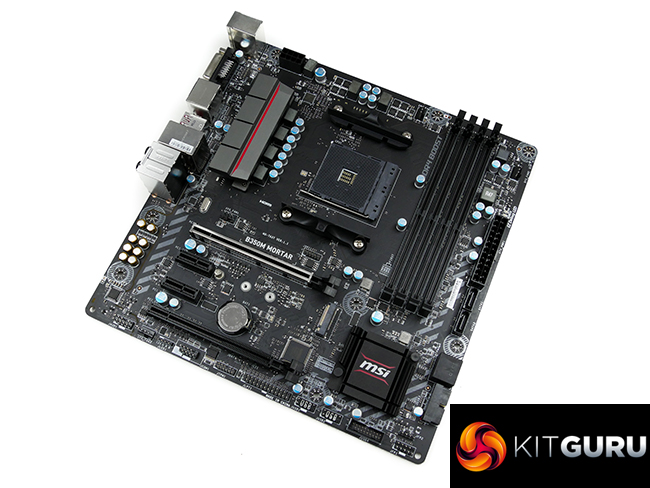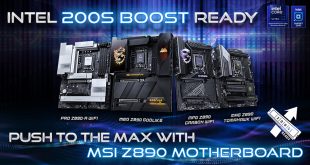The MSI B350M Mortar keeps many of the good features seen on the ATX Tomahawk but shrinks the package into a micro-ATX form factor.
Performance was solid across our range of tests. There were no glaring weaknesses for the B350M Mortar against B350 competition. That's with the exception of USB transfer rates where Gigabyte's competing options and their 10Gbps USB 3.1 Gen 2 ports decimate all rivals. Power consumption was a positive for the B350M Mortar thanks to reduced PCB area leading to less energy waste.
Overclocking performance was fine but, somewhat surprisingly, was not as strong as the ATX B350 Tomahawk. That's despite the power delivery solutions being practically identical, except for an additional heatsink for MSI's ATX part. Our chip would not hit its 4050MHz limit with the B350M Mortar, which is the same outcome we have seen from Gigabyte and ASRock B350 offerings at this price point.
Still, 4GHz on an 8-core Ryzen 7 is a decent result for a £90 micro-ATX motherboard. Game Boost also worked correctly, even if the applied voltage of around 1.45V is too high for comfort with prolonged heavy usage on a motherboard with this calibre of power delivery hardware.
USB Type-C, despite being limited to 5Gbps transfer speeds, is a good addition for this motherboard. The same can be said about a 4K60-capable DisplayPort output that may be a major point for AM4 APU users (depending on the APUs' capabilities, of course). Optical SPDIF and an adequate cohort of 3.5mm audio jacks are further positives. However, the lack of 10Gbps USB 3.1 Gen 2 is disappointing and limits this board's external transfer capabilities to less than 500MBps at most.
Fan control is generally a strength for the MSI B350M Mortar. Control options are good, even if the sensor inputs are limited and useful preset modes are non-existent. Four 4-pin headers is a good amount of connectivity for a budget micro-ATX motherboard.
Unfortunately, the same cannot be said about MSI's very poor ‘RGB' LED system. This was a major disappointment for the ATX B350 Tomahawk but it's even more frustrating on the B350M Mortar where its micro-ATX environment leaves less room for RGB LED accessory expansion outside of the motherboard. The same limited expansion point can be made regarding the four SATA ports as a cheap PCIe-to-SATA adapter eats up valuable slots that are far less prevalent on a micro-ATX motherboard.
The MSI B350M Mortar is available at Overclockers UK for £88.99. A three-year manufacturer warranty is provided.
MSI's B350M Mortar is a solid option for budget users who want a micro-ATX Ryzen system. There are plenty of good traits with the motherboard but there are also a number of compromises compared to competitors at the price point, primarily from Gigabyte. Lower cost offerings, such as the B350M Bazooka, also represent stiff competition due to their loss in features that may be perceived as minimal by some consumers.
Discuss on our Facebook page, over HERE.
Pros:
- Very good stability with 3200MHz RAM using A-XMP.
- PCIe 2.0 x4 slot is good for supplementary high-bandwidth expansion.
- Respectable number of fan headers with decent overall control.
- USB Type-C, even if it is limited to 5Gbps bandwidth.
- Easy-to-use UEFI.
- DisplayPort for 4K60 output with an AM4 APU.
- Five audio jacks as well as optical SPDIF will please surround sound users.
Cons:
- Poor RGB LED system that is not ‘true' 16.7 million colour RGB.
- Only four SATA ports and no 10Gbps USB 3.1 Gen 2.
- Cooling for all the power delivery solution would be preferred.
KitGuru says: A solid option with Type-C USB and a well-polished, stable UEFI.
 KitGuru KitGuru.net – Tech News | Hardware News | Hardware Reviews | IOS | Mobile | Gaming | Graphics Cards
KitGuru KitGuru.net – Tech News | Hardware News | Hardware Reviews | IOS | Mobile | Gaming | Graphics Cards






Hi can tomahawk and mortar memory oc to 3600mhz?
Hello can anyone tell me which ram is compatible with msi b350m mortar
Not sure with mortar but my tomahawk run 3200 easily with flare x
Hey Kitguru did you run into any issues with main board thermal sensor during your testing or rather do you know what the main board thermal sensor is actually measuring because I’m running the main board with a r5 1600 at 4ghz 1.4v and Main board sensor is reporting 98°C after 15min of prime95. Which seems stupidly hot given that I’ve got 4Nidec Servo GentleTyphoon 120 mm 2150 RPM fan’s in the case. I kinda just wanna know first of all if that thing is the VRM sensor or “chipset” because which ever one it is guess I’ll add to the custom loop. Because 98°C during stress test just doesn’t sit well with me…